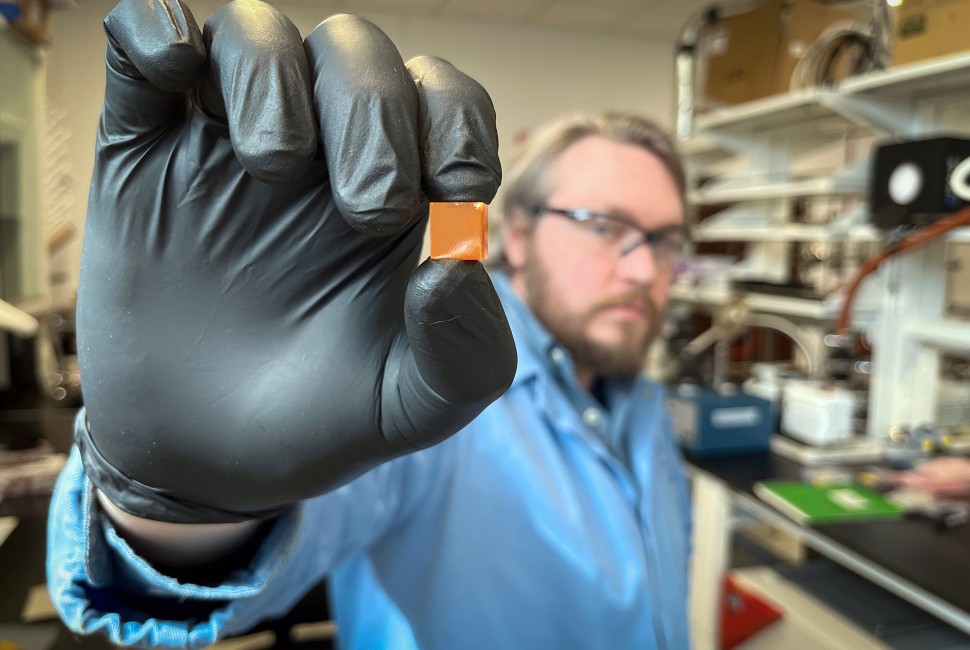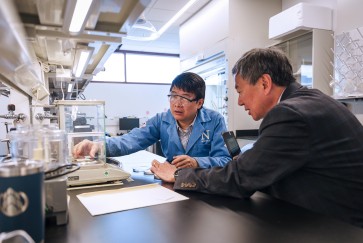This article is part of a series on companies in Northwestern’s Querrey InQbation Lab.
A decade ago, Northwestern chemistry professor Mercouri Kanatzidis and other scientists discovered that cesium lead bromide, a material being studied for applications in solar cells, has the ability to detect high-energy X-rays and gamma rays. The material offered promise in a number of potential applications, including biomedical imaging, such as CT and SPECT scans, and the detection of nuclear materials. After spending years developing the material, improving the purity and scaling it up in the lab, the scientists reached a turning point.
“We thought this could be a breakthrough material in X-ray and gamma ray detection — a field that has been clamoring for a new material for 40 years — so we decided to create a startup,” Kanatzidis said. “Northwestern is very supportive in commercializing its inventions. The University licensed the technology to our company, connected us to investors and provided us with quality space and infrastructure.”
Kanatzidis and Duck Young Chung, a staff scientist at Argonne National Laboratory, founded Actinia in 2020, and the company moved into Northwestern’s Querrey InQbation Lab in November 2021. Actinia was in the cohort of first tenants in the new incubator that houses Northwestern startups at 1801 Maple Ave., in downtown Evanston, just a short walk from campus.
Halving the radiation dose
In biomedical imaging, nondestructive testing (techniques used to analyze a material, component or system while leaving it intact) and the search for misplaced nuclear materials, high-resolution images are important. The young company is developing cutting-edge radiation detector materials for common imaging techniques used in medicine as well as security and nondestructive testing of electronics. The new detectors would allow for a halving of the radiation dose, or a doubling of image resolution, compared to common scintillator-based detectors on the market today.
“We are excited to be working on a promising new material for medical diagnostics and imaging, homeland security and nuclear safety,” Kanatzidis said.
Actinia’s senior scientist Grant Alexander is growing high-quality perovskite crystals of cesium lead bromide, the material identified 10 years ago by Kanatzidis’ lab as promising for gamma-ray detection. The company next would like to add an expert in the fabrication and testing of detectors who can serve as a bridge between materials and the engineering of the system.
The Querrey InQbation Lab provides excellent and inexpensive space for chemical synthesis and purification, which can be challenging for startup companies to find in the Chicago area. Features include wet labs, the availability of compressed air and nitrogen, waste disposal and mandatory safety training. Another benefit of the space is its close proximity to Northwestern, providing access to a variety of experts and the University’s other shared scientific facilities.
Improved images of organs or whole-body scans
Semiconductors, which Actinia is developing, offer better energy and spatial resolution for radiation detection than scintillators, the technology currently used by the vast majority of companies in the medical and security industries. These features translate to improved images of individual organs or whole-body scans at a lower radiation dose for patients as well as more sensitive discrimination of materials in the security and industrial inspection spaces.
Semiconductors, however, are challenging to work with, which is why cadmium zinc telluride (CZT) is the only room-temperature material in commercial use. CZT is expensive, sensitive to high doses of radiation and must be maintained at low temperatures. Using cesium lead bromide, Actinia is developing an inexpensive, efficient and high-quality semiconductor detector that works at room temperature to take CZT’s place.
If you have a commercializable idea or product and are addressing a problem in society, you should strongly consider taking a risk and starting a company.”
Acting CEO of Actinia
“There has never been a better time to start a company within academia, in terms of the level of support to faculty and student entrepreneurs,” said Josh Palmer, acting CEO of Actinia. “This is definitely true at Northwestern. My advice to aspiring faculty and student entrepreneurs is that, if you have a commercializable idea or product and are addressing a problem in society, you should strongly consider taking a risk and starting a company.”
Palmer, a chemist by training, is a principal with Kairos Ventures, a firm that works with top universities, including Northwestern, to commercialize scientific discoveries. He praised the University’s Innovation and New Ventures Office (INVO) as one of the most proactive and active technology transfer offices in the country.
“INVO is very supportive of faculty, including new faculty members, doing entrepreneurial work,” Palmer said. “You can see the successful results of this support everywhere.”
“The InQbation Lab is much more than physical space for companies,” said Lisa Dhar, associate vice president for Innovation and New Ventures. “By enabling a community for our startups, we have the opportunity to deepen and expand our network, bringing critical partners such as Kairos into the Northwestern ecosystem.”
Named in honor of Kimberly K. Querrey (’22, ’23 P), chair of the Innovation and Entrepreneurship Committee of Northwestern’s Board of Trustees, the Querrey InQbation Lab provides a home for Northwestern’s highly entrepreneurial faculty to contribute to innovation through commercialization of sophisticated scientific discoveries as well as bring economic growth and opportunities to the Evanston and Chicago communities.
The multimillion-dollar technology accelerator not only honors Querrey’s vision and support — the “Q” in InQbation also represents the critical questions Northwestern’s researchers will explore in their quest to advance our understanding of the world and improve human health.
Kanatzidis has a financial interest in and affiliations with Actinia. Northwestern University has financial interests (equities, royalties) in Actinia.
Northwestern’s Innovation and Entrepreneurship ecosystem strives to strengthen entrepreneurial activity by students and faculty and build a self-sustained and collaborative community that moves ideas beyond academia and into the market, generating innovations to benefit society.


